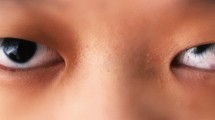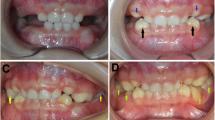Abstract
Oculofaciocardiodental (OFCD) syndrome is a rare genetic disease, first reported by Hayward in 1980. This syndrome presents with various ocular, facial, cardiac, and dental symptoms, including congenital cataract, dysmorphic facial features, congenital heart disease, and enlarged roots, respectively. The most important criteria for the diagnosis of OFCD syndrome are dental abnormalities, especially extreme elongation of canine roots. Here, we report detailed analysis of the dentofacial region, as well as ocular, facial, cardiac, and dental findings in a female with OFCD syndrome. To the best of our knowledge, the patient in this case is the first such patient reported in South Korea.



Similar content being viewed by others
References
Hayward JR. Cuspid gigantism. Oral Surg Oral Med Oral Pathol. 1980;49:500–1.
Marashi AH, Gorlin RJ. Radiculomegaly of canines and congenital cataracts-a syndrome? Oral Surg Oral Med Oral Pathol. 1990;70:802–3.
Marashi AH, Gorlin RJ. Radiculomegaly of canine teeth and congenital cataracts: confirmation of a syndrome. Am J Med Genet. 1992;42:143.
Gorlin RJ, Marashi AH, Obwegeser HL. Oculo-facio-cardio-dental (OFCD) syndrome. Am J Med Genet. 1996;63:290–2.
Schulze BR, Horn D, Kobelt A, Tariverdian G, Stellzig A. Rare dental abnormalities seen in oculo-facio-cardio-dental (OFCD) syndrome: three new cases and review of nine patients. Am J Med Genet. 1999;82:429–35.
Ng D, Thakker N, Corcoran CM, Donnai D, Perveen R, Schneider A, et al. Oculofaciocardiodental and Lenz microphthalmia syndromes result from distinct classes of mutations in BCOR. Nat Genet. 2004;36:411–6.
Feberwee H, Feenstra I, Oberoi S, Sama IE, Ockeloen CW, Clum F, et al. Novel BCOR mutations in patients with oculofaciocardiodental (OFCD) syndrome. Clin Genet. 2014;85:194–7.
Marseillier É (1937) Les dents humaines: morphologie. Bordas Editions. Paris: Dunod Editeur
Tsukawaki H, Tsuji M, Kawamoto T, Ohyama K. Three cases of oculo-facio-cardio-dental (OFCD) syndrome. Cleft Palate Craniofac J. 2005;42:467–76.
Kawamoto T, Motohashi N, Ohyama K. A case of oculo-facio-cardio-dental syndrome with integrated orthodontic–prosthodontic treatment. Cleft Palate Craniofac J. 2004;41:84–94.
Kim KH, Choy KC, Kim HG, Park KH. Cephalometric norms of the hard tissues of Korean for orthognathic surgery. J Korean Assoc Oral Maxillofac Surg. 2001;27:221–30. (Korean)
Van Doorne L, Wackens G, De Maeseneer M, Deron P. Otodental syndrome: a case report. Int J Oral Maxillofac Surg. 1998;27:121–4.
Solanki M, Patil SS, Baweja DK, Noorani H, Shivaprakash P. Talon cusps, macrodontia, and aberrant tooth morphology in Berardinelli-Seip syndrome. Oral Surg Oral Med Oral Pathol Oral Radiol Endod. 2008;105:e41–7.
Sirmaci A, Spiliopoulos M, Brancati F, Powell E, Duman D, Abrams A, et al. Mutations in ANKRD11 cause KBG syndrome, characterized by intellectual disability, skeletal malformations, and macrodontia. Am J Hum Genet. 2011;89:289–94.
Korones SB, Ainger LE, Monif GRG, Roane J, Sever JL, Fuste F. Congenital rubella syndrome: study of 22 infants. Myocardial damage and other new clinical aspects. Am J Dis Child. 1965;110:434–40.
Cai J, Kwak S, Lee JM, Kim EJ, Lee MJ, Park GH, et al. Function analysis of mesenchymal Bcor in tooth development by using RNA interference. Cell Tissue Res. 2010;341:251–8.
Fan Z, Yamaza T, Lee JS, Yu J, Wang S, Fan G, et al. BCOR regulates mesenchymal stem cell function by epigenetic mechanisms. Nat Cell Biol. 2009;11:1002–9.
Lapthanasupkul P, Feng J, Mantesso A, Takada-Horisawa Y, Vidal M, Koseki H, et al. Ring1a/b polycomb proteins regulate the mesenchymal stem cell niche in continuously growing incisors. Dev Biol. 2012;367:140–53.
Maden M, Savgat A, Görgül G. Radiculomegaly of permanent canines: Report of endodontic treatment in OFCD syndrome. Int Endod J. 2010;43:1152–61.
Author information
Authors and Affiliations
Corresponding author
Ethics declarations
Conflict of interest
All authors declare that they have no conflict of interest.
Human rights statement and informed consent
This article does not contain any studies with human or animal subjects performed by any of the authors.
Rights and permissions
About this article
Cite this article
Oh, S.H., Kang, J.H., Kang, J.H. et al. Radiculomegaly of canines in oculofaciocardiodental syndrome. Oral Radiol 35, 326–330 (2019). https://doi.org/10.1007/s11282-018-0356-6
Received:
Accepted:
Published:
Issue Date:
DOI: https://doi.org/10.1007/s11282-018-0356-6




